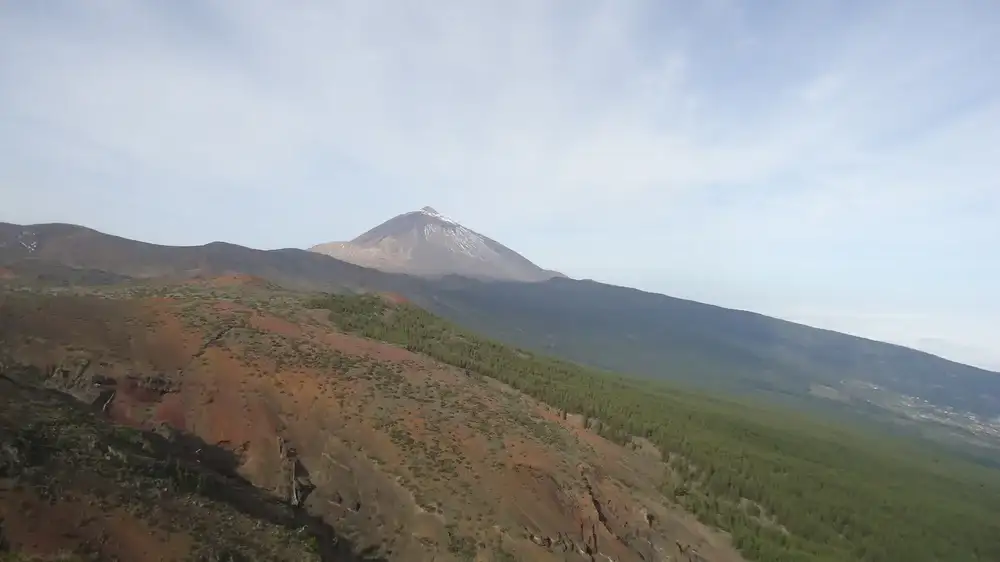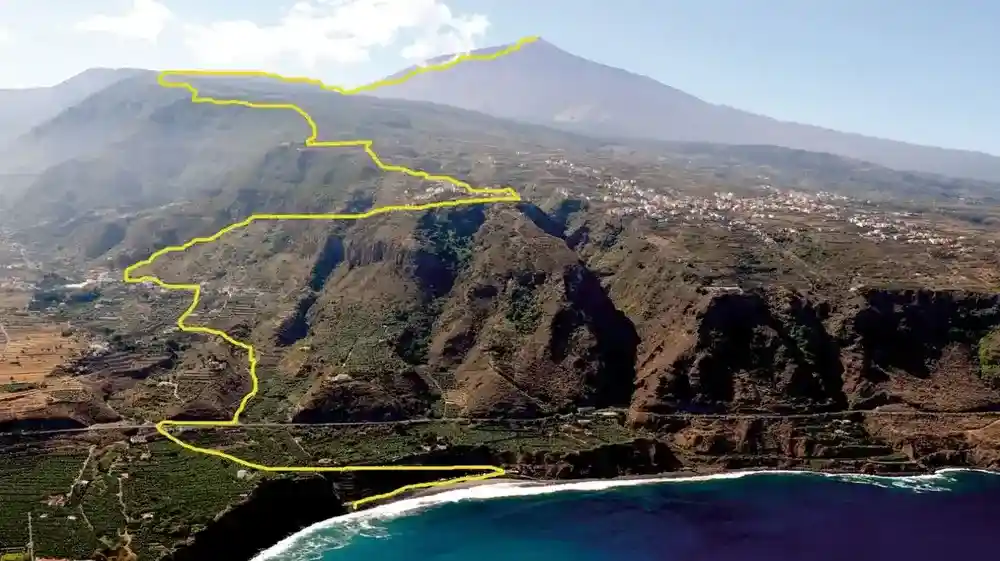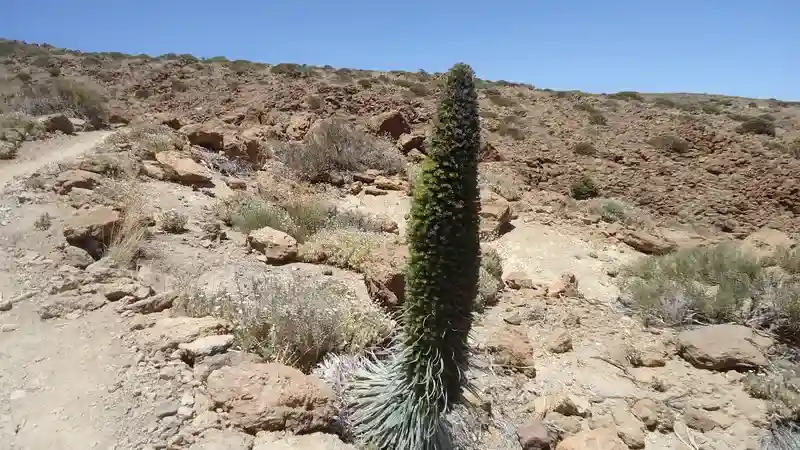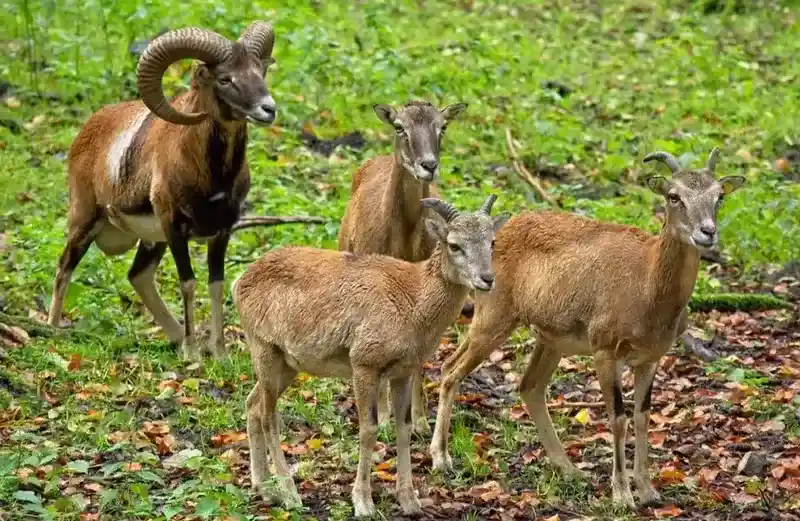If you plan climbing Mount Teide from sea level, you can start almost from anywhere, this is an island and the mountain summit is its highest point. But bear in mind its elevation, so it is best to choose the shortest route.
Mount Teide is usually climbed from the sea level by starting from Playa del Socorro because this is the shortest approach. Even in this case the route is around 27 km long, and you have to climb no less than 3718 meters.
This can be done in under 11 hours if you are in a very good shape. But the current record seems to be 3 hours and 33 minutes, hard to believe.

Teide 0-4, 0-4-0, and 0-4-2 sea to summit routes
What is Teide 0-4 route?
In short, this is a climb from the sea level (hence the number 0) to the summit. People also climb some smaller peaks on the way up to accumulate the total ascent to 4000 meters (hence the number 4).
But what when you get to the summit? Well, there is a cable car with the station that is 163 meters below the summit, so you descend that way.
However, if this is not purist enough, see the other two options below.
What is Teide 0-4-0 route?
Perhaps you guessed already. This is as follows – you start from the sea level which is literally 0, go to the summit, and then descend the same or some other way back to the sea level.
But hey, do not get excited about this too much. This is around 57 kilometers in the shortest case, and not many people are able to do this.
What is Teide 0-4-2 route?
This implies going from the sea to the summit, and then descending to the car parking which is below Montana Blanca at an elevation of around 2350 meters. Hence the number 2.
To do this, you would need to have somebody to pick you up from the car parking. But you can also go there by car, park the car, and then take a bus to Puerto Santa Cruz to start the tour. You will need bus time tables, so you can see them in the Titsa bus operator site.
For any of the three options, the ascent route from the sea is roughly marked in this picture:

Teide 0-4 route map
The wikiloc map below was prepared by my friend Angel de Vicente who did the climb in 10 hours 45 minutes. It is zoomable so you can check details. As you see, the start point is at Playa del Socorro which is a few kilometers west of Puerto de la Cruz.
The access is from the north and the lower part of the route goes through inhabited areas, with many switchbacks and, from what I know, without any marks. So it may be difficult to find the route without some GPS tool.
But I have seen in some more recent texts that the route has been marked in 2018. I am not sure about this, so if somebody knows more it would be good to have such an information here.
This is why it may be useful to check it before you climb. You can climb the lower part separately to learn the route, this may save your time later. If you do not have a GPS tool, a rough rule is, when you have streets and roads that split, always take the steepest one.
The start point at Playa del Socorro is in what is known as Los Realejos, so just to know what to say to your taxi driver if this is how you plan to get there.
You will be passing through banana plantations before taking on steep streets and paths towards the Corona forest. The route will eventually join the standard route from the car parking at Montana Blanca.
Protected areas
This is the north side of the island and the route goes through several protected natural reserves which adds to the beauty of this adventure. But this also requires responsible behavior in such an environment.
You will be passing through Rambla de Castro, Tigaiga, Campeches and Ruiz, the Corona Forestal. Note also that this all is the Teide National Park with a very specific ecosystems at various altitudinal zones.
There are endemic plants growing on these islands only, the Tajinaste Rojo in the picture below is one of them.

The mentioned Corona Forestal is the result of the humidity caused by the trade winds. This is a beautiful and green area and a stronghold of a variety plant and animal species.
There are muflons in this area, they were introduced here from the Alps. There may be situations of ‘muflons control’, meaning hunters are in the area and there will be shooting.
On such occasions, there are signs posted in certain areas where access is temporarily forbidden.

Time needed for the Teide sea to summit route
I have see various numbers around. If you are an ordinary mortal but in a good shape, think about 11-12 hours.
- However, regarding the record time for the Teide 04 tour, I have seen the number of 3 hours and 33 minutes (one way). I know the mountain well, and I know how demanding it is. So when I see such numbers, I am simply astonished.
- For the Teide 040 tour, the best time I have seen so far seems to be of an Austrian, Thomas Summer who did it in 6 hours 16 minutes and 53 seconds. But I have see also an information about Manual Marillas who did it in 5:26:28. For females, this is Swedish Emelie Forsberg with the time of 7 hours 6 minutes and 6 seconds.
Now you know it, so go there and do your best.
Preparing steps and tips for Teide sea to summit tour
Teide permit
If you do not know, you need a permit to climb Teide. Some 163 meters below the summit there is a check point. However, the guard is there only during working hours of the lift.
So if you know that you will surely be there after that, there will be nobody to check your permit. Now, use your imagination.
But follow the link above to my post and there is a link where you can apply for the permit. It is free but this must be done months in advance.
Do you need a guide for this tour
If you have climbed Mount Teide the usual way from the road and the main crater area, then you already know the upper route. But this route is self-evident in any case so you can this without a guide.
As for the lower part of the route, it is in an inhabited area, so you can always give up and get back. The central part of the route will be through the woods, and in this part the direction should always be obvious.
It is advisable to try the lower part and to get familiar with the route, and this is mainly to save the time during your actual climb.
⇒ Related: Can You Climb Mount Teide Without a Guide?
This is a video prepared by Angel, so have a look, you will get some idea of the route:
Note that you can get in touch with him through the page where he described the tour.
Acclimatization
So this is something that can ruin all your plans. There is no way to predict it. But note that even if you fail once, this does not mean you will feel the same next time.
I have had altitude sickness on El Teide in some of my 8 climbs, but in some other climbs I did not have any symptom at all.
I even suffered once when I climbed the nearby Guajara mountain. But I climbed it several times without any issue.
However, acclimatization indeed works, so if you have time, make sure you spend at least a day or two in the great crater area. There are peaks around that go over 2300 meters, so climb some of them.
Even if you are perfectly acclimatized, you will feel the altitude, take my word for this. But this is normal, so listen to your body and do not push too much.
Equipment and clothing
I have a separate text on the issue of clothing when you climb El Teide at night. There is not much new to add here. Just bear in mind that this is an island with eternal spring climate at the sea level.
But you may have incredibly strong winds on the summit and sub-zero temperature. So be prepared for all this and have extra layers in the pack.
In the forest area you may be walking through the clouds as well. This is not a big deal as it is never cold there. I have been completely wet in my tours in Anaga forest where I would walk in the rain for hours. But when you are high, the story is completely different. So have a rain layer in the pack.
For a day tour you need a day pack, but if you plan to do it more slowly and carry a tent, you will need a bigger pack. It should be large enough for your sleeping pad and sleeping bag, plus a tent if you carry it.
Water
You will need it a lot. This is individual and I cannot tell you how much you need.
I mentioned inspecting the route before you climb it. So perhaps you might want to stash some water. Then if you are on the 0-4-0 tour, you can have it when you go down.
You can also get to the Montagna Blanca car parking and take a walk until the area where you will see the route from the north sea side. So here you can stash a bottle or two to wait for you when you climb. You can then use it for 0-4-0 and also for 0-4-2 tour.
There is Altavista hut below the summit, so here you can have all you need, food and water as well.
Cable car reservation
You might need this if you plan to descend by using the cable car. So follow this link to see more and to book a ticket.
Weather situation
In the link below you can get an accurate information:
When I was writing this text, the summit temperature was around zero degrees Celsius.
Blisters issue
This is again something individual and it depends on a variety of factors. But this also can ruin your plans. So have something to avoid blisters. React immediately if you start feeling something.
I cannot stress strong enough the following: do not even think of going there in a pair of brand new boots. This just in case that you are new to the island, and decide on an impulse to climb the mountain from the sea. You will suffer if you do this.
You might want to have a blister prevention cream, some blister prevention tapes, and band-aids. I normally always have two pairs of socks on my feet, one thin and one thick. You might want to add one pair if thin socks to use if those that are on your feet are wet.
This is more or less all I had to say about climbing Mount Teide from sea level. As you realize, there are three variants of doing this, all three are hard, but 0-4-0 tour is by far the hardest of course.
Thank you for reading. Let me know if you have questions, there is a comment box below. Bookmark this site and keep as a reference, you will always have new texts added here.
Leave a Reply